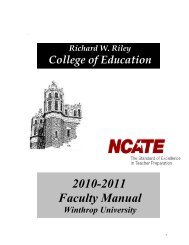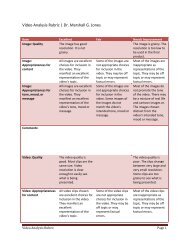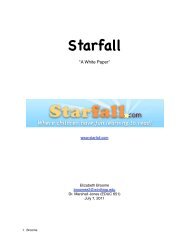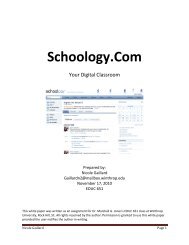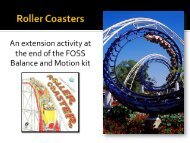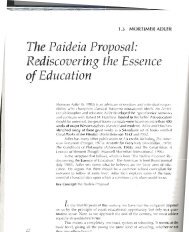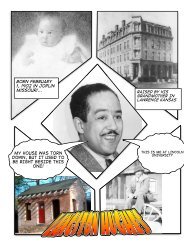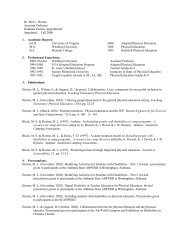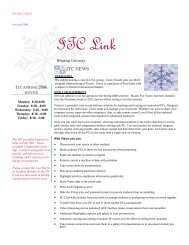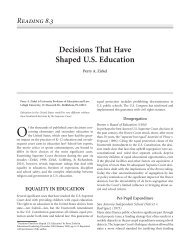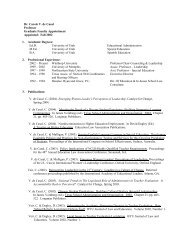June 19 - FOSS Magnetism and Electricity Kit - Winthrop University
June 19 - FOSS Magnetism and Electricity Kit - Winthrop University
June 19 - FOSS Magnetism and Electricity Kit - Winthrop University
Create successful ePaper yourself
Turn your PDF publications into a flip-book with our unique Google optimized e-Paper software.
ELEM 631<br />
Dr. Linda Pickett<br />
<strong>Winthrop</strong> <strong>University</strong>
“Keep away from people who try to<br />
belittle your ambitions. Small<br />
people always do that, but the<br />
really great make you feel that you,<br />
too, can become great.”<br />
- Mark Twain
Agenda<br />
Revised rubrics for presentation <strong>and</strong><br />
narrative<br />
<strong>FOSS</strong> <strong>Magnetism</strong> <strong>and</strong> <strong>Electricity</strong> <strong>Kit</strong><br />
– <strong>Magnetism</strong><br />
– <strong>Electricity</strong><br />
– Electromagnetism<br />
Assessment ideas for Elementary Science
<strong>FOSS</strong> Program<br />
Any prior experiences?<br />
Coordinated science curriculum from the<br />
Lawrence Hall of Science – <strong>University</strong> of<br />
California, Berkeley<br />
Research-based<br />
Classroom-tested<br />
Based on brain research <strong>and</strong> children’s<br />
developmental stages – look at Thinking<br />
Processes on chart on page 152
Inquiry<br />
Instructional Pedagogies<br />
H<strong>and</strong>s-on Active Learning<br />
Multisensory Methods<br />
Student-to-Student Interactions<br />
– Grades 3-6 - groups of 4 <strong>and</strong> share materials<br />
– Grades K-2 – work in groups but have own materials<br />
“Working alone...together”<br />
Discourse <strong>and</strong> Reflective Thinking
Assessing Student Learning<br />
Content Knowledge<br />
Conducting Investigations<br />
Building Explanations<br />
Assessment Strategies:<br />
– Observations <strong>and</strong> interviews<br />
– Scoring guides <strong>and</strong> recording strategies<br />
– Short summative test <strong>and</strong> system for portfolio<br />
assessment
Quick Write<br />
Engage<br />
Please write three things you know about<br />
magnetism.<br />
What experiences you have had with<br />
magnetism?
Neodymium Magnets<br />
Engage<br />
NIB magnet (also called a rare earth<br />
magnet) is a powerful magnet made of a<br />
combination of neodymium, iron, <strong>and</strong><br />
boron<br />
Used for stabilization <strong>and</strong> angular head<br />
motors in computer hard drives
A neodymium magnet lifting<br />
1300 times its own mass<br />
How much could you lift if you<br />
were a neodymium magnet?
Magnetic Observations<br />
Exploration<br />
Staying seated, use your magnet to explore.<br />
– What are some of the things it sticks to?<br />
Put magnets aside<br />
Sort test objects into 2 groups:<br />
– things that will stick to a magnet<br />
– things that will not stick to a magnet<br />
Test to confirm predictions Page 169
Exploration<br />
Page 169<br />
Test objects in classroom – do not put<br />
magnets near computers, screens, credit<br />
cards, CDs, jump drives.<br />
What happens when two magnets come<br />
together?<br />
Can you make a temporary magnet out of<br />
a nail?
Explanation<br />
What do magnets stick to?<br />
– Objects made of iron or steel<br />
Why does it stick to the rock?<br />
– Lodestone – contains the mineral magnetite<br />
which is rich in iron<br />
Attract <strong>and</strong> Repel<br />
– Put 4 magnets on a pencil <strong>and</strong> make them<br />
“float”
Breaking the Force<br />
Elaboration <strong>and</strong> Extension<br />
Materials<br />
1 magnet-on-a-post<br />
1 magnet<br />
1 balance<br />
2 plastic cups<br />
1 bag of washers<br />
6 spacers<br />
Paper to record data
Breaking the Force Investigation<br />
1. Put the magnet on a post in the hole on<br />
the bottom of the balance.<br />
2. Put the cups in the holes.<br />
3. Put the doughnut magnet in the cup<br />
above the magnet on a post.<br />
4. Stack washers in the other cup until you<br />
break the force between the two<br />
magnets.
Initials<br />
Data Table<br />
Please enter the # of washers that “broke the force”<br />
Number of spacers<br />
0 1 2 3 4 5 6<br />
SS 17 10 Do 6 5 4 4<br />
Not<br />
BM <strong>19</strong> 11 5 5 4 3<br />
JE 16 10 Test 6 5 4 4<br />
Yet
Graph the Data – Page 171<br />
Use the recording sheet: The Force<br />
Independent variable? Where does it go?<br />
# of spacers – X axis<br />
Dependent variable? Where does it go?<br />
# of washers – Y axis<br />
Plot the data points<br />
Do not connect points with straight edge<br />
Interpolate - Hypothesize # of washers for<br />
2 spacers<br />
Test to confirm your hypothesis<br />
Share a graph
What do the graphs mean?<br />
The points represent the relationship between:<br />
– The distance between the two magnets (# of<br />
spacers) <strong>and</strong><br />
– The force of the magnetic attraction between<br />
the two magnets (# of washers needed to<br />
“break the force”).<br />
Curved (sloped) graph – is a non-linear graph that<br />
indicates the relationship between the two<br />
variables. It means the relationship between the<br />
two variables is not constant.<br />
Extrapolate – predict for more than 6 spacers
Use graphs to draw conclusions<br />
Explanation<br />
Washers are used to quantify the force<br />
of the magnetic attraction between two<br />
magnets.<br />
The greater the distance between two<br />
magnets, the weaker the force of the<br />
magnetic attraction between them.
Word Bank<br />
Explanation<br />
Force<br />
– A push or pull<br />
Magnet<br />
– An object that sticks to iron<br />
<strong>Magnetism</strong><br />
– A specific kind of force<br />
Attract<br />
– When magnets pull together<br />
Repel<br />
– When magnets push apart
Temporary magnet<br />
Word Bank<br />
Explanation<br />
– A piece of iron or steel that behaves like a magnet<br />
when it is touching a permanent magnet<br />
Permanent magnet<br />
– Permanent magnetic fields have been induced <strong>and</strong><br />
will remain unless the magnet is dropped or heated.<br />
– Used to be made of iron, but now aluminum, nickel,<br />
cobalt, ferrite, neodymium are used to make<br />
powerful, long-lasting magnets.
Making Connections<br />
Lighting a Bulb<br />
Materials: 2 light bulbs, 2 D-Cells, 2<br />
short wires, 1 circuit base
Use a D-Cell <strong>and</strong> two wires (no light<br />
bulb holder) to light the bulb.<br />
Trace the path of electricity.<br />
Now light the bulb using only one wire.<br />
Again, trace the path of electricity.<br />
Pages 172-173
Circuit - A pathway for the flow of electricity – by<br />
convention we say it goes from negative to<br />
positive<br />
The electricity must travel in a complete path<br />
(circle) from one end of the battery, through the<br />
parts of the circuit <strong>and</strong> back into the battery.<br />
Filament - The part in a light bulb that gets hot<br />
<strong>and</strong> produces light<br />
Look at Response Sheet – Bulbs (page 174)<br />
– Do you think the bulb will light?<br />
H<strong>and</strong>s-on Circuit Activity
Put the light bulb in the holder <strong>and</strong> put<br />
the battery in the battery holder on the<br />
circuit base.<br />
Push down on the Fahnstock clips to<br />
insert the wires.<br />
Light the bulb.
Making a Motor Run<br />
Pick up a motor<br />
Build a circuit , using 1 D-cell, that<br />
will make the motor run.
Get a switch.<br />
Wire in the switch so you can turn<br />
the motor on <strong>and</strong> off.<br />
What does the switch do?<br />
Opens <strong>and</strong> closes the circuit.<br />
Build a circuit that will light 1 light<br />
bulb <strong>and</strong> can be turned on <strong>and</strong> off<br />
with a switch.
Finding Conductors <strong>and</strong><br />
Insulators – p. 175<br />
Pick up 2 long wires <strong>and</strong> a bag of test<br />
objects<br />
Sort test objects into two groups:<br />
Conductors – conduct electricity<br />
Insulators – do not conduct electricity<br />
Set up testing circuits <strong>and</strong> confirm<br />
hypotheses
Concepts<br />
All metals are conductors.<br />
Metals that are covered with an<br />
insulating layer will not conduct<br />
electricity.
Building Series Circuits<br />
Turn in motors <strong>and</strong> 2 long wires<br />
Pick up 2 nd light bulb in holder, 1<br />
additional short wire, <strong>and</strong> 1 switch<br />
Build circuit that will light two bulbs<br />
with one battery<br />
Why are the light bulbs dim?
Use 2 nd battery in holder to make two<br />
light bulbs burn brightly.<br />
– Use wire to connect the two batteries<br />
– How do batteries have to be positioned?<br />
Series circuit - a circuit with only one<br />
pathway for current flow<br />
Students do Page 176 as an assessment
Building Parallel Circuits<br />
You will need 2 long wires <strong>and</strong> 4 short<br />
wires<br />
Use 1 battery to get 2 light bulbs burn<br />
brightly. Students use page 177 to<br />
record their solutions.<br />
Try some of the different solutions<br />
shown on Elmo.<br />
Parallel circuit - splits into two or more<br />
pathways before coming together at the<br />
battery
Online resources<br />
Game<br />
Jeremy – iPad apps
Current Attractions<br />
Part 1: Building an Electromagnet<br />
Materials: 1 rivet, 1 electromagnet wire, 1<br />
short wire, 1 circuit base, 1 D-cell, 1<br />
switch, 1 bag of small washers<br />
Work with your partner to make an<br />
electromagnet that will lift the washers.
Electromagnet<br />
Word Bank<br />
– A coil of insulated wire, usually wound around a core<br />
of iron or steel, which produces a magnetic field<br />
when electricity flows through the wire.<br />
Core<br />
Coil<br />
– The material around which a coil is wound<br />
– Insulated wire wound repeatedly around a central<br />
core
Concepts<br />
A magnet can be made by winding an<br />
insulated wire around an iron core <strong>and</strong><br />
running current through the wire.<br />
The magnetism produced by an<br />
electromagnet can be turned on <strong>and</strong> off.
Part 2: Changing Number of Winds<br />
How can you change the strength of an<br />
electromagnet?<br />
Groups of 4<br />
Materials: 1 rivet, 1 electromagnet wire, 1 short<br />
wire, 1 circuit base, 1 D-cell, 1 switch, 1 cup of<br />
small washers<br />
Recording sheet: Winding Electromagnets –<br />
page 178
Concepts<br />
What was the general pattern you saw in<br />
the way the number of winds affects the<br />
strength of an electromagnet?<br />
The more winds on the core of an<br />
electromagnet, the stronger the<br />
magnetism.
Switch<br />
to PP
It is assessment that helps us<br />
distinguish between teaching <strong>and</strong><br />
learning.
Prior Knowledge <strong>and</strong> Alternative<br />
Assessment Strategies<br />
Brainstorming<br />
Discussions<br />
Think-pair-share<br />
Concept maps<br />
Drawings<br />
Venn Diagrams <strong>and</strong> written summaries<br />
Science journal/notebooks entries
Design assessment strategies that are<br />
easy for your students to underst<strong>and</strong> <strong>and</strong><br />
provide different ways for them to<br />
demonstrate their learning.<br />
Try to grade work <strong>and</strong> activities done in<br />
class as much as possible<br />
Page 302 in your packet<br />
Feel free to use or modify any of these<br />
ideas when you are designing<br />
assessments for your lesson plans.
Unit is due on Thursday<br />
Turn in hard copies of the three lesson<br />
plans with all required activity sheets,<br />
assessments, <strong>and</strong> attachments<br />
Please label each Lesson Plan as 1, 2, or 3<br />
Include a rubric with each lesson plan<br />
Submit each lesson plan <strong>and</strong> all<br />
attachments to Live Text by 1:00 on<br />
Thursday – be sure to submit as correct<br />
assignments



